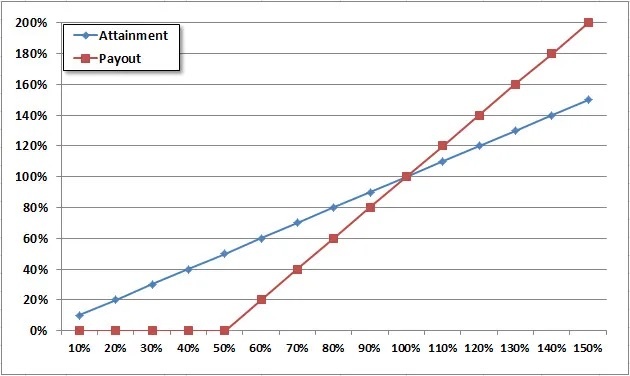As workplaces evolve, the emphasis on how happy you are in your workplace rises. Do you feel appreciated? Can you work from home? Does your work offer a flexible schedule to help with kids or appointments? Etc. However, this does not mean that the amount you get paid is any less important. Over 40% of workers say they would be willing to leave their companies for a 10% increase in pay. This means that sales commission is just as important as ever when it comes to not only attracting employees but also retaining them. As many employees affiliate their pay with how appreciated they are, this is not surprising. Imagine if half of your sales team left due to poor compensation? The aftermath of this event would be a difficult one.
As a salesperson, it is important to know what types of sales commission structures are available and what ones you should look for from employers. Also, it is equally as important as an employer to understand the various commission structures so you know which structure is best for your team.

Where To Start
Simple Is Best
Don’t make a super complicated commission structure that your sales reps have to constantly grab the cheat sheet for if they have any questions. This will only make the commission structure hard to implement. The structure in place should be simple enough that any one of your sales reps can think “If I do X I will make $Y”.
Don’t Put A Ceiling
By capping salaries, you are only putting a limit on your sales reps’ hard work and potentially their initiative. By decreasing the earnings potential of your sales reps, you are showing that as management you are not supporting their hard work and going above and beyond. You should support all your sales reps if they have the ability to shoot for the stars and to reach them.
No Redos
When you are dealing with sales commissions there is no room for restructuring or changes. Introducing updated and altered sales commissions moves your sales goals and targets. Which in turn can decrease their morale and motivation. Think about it from your end, if your boss came in and restructured your pay, how would you react?
Types of Sales Commission Structures
Base Salary Plus Commission
This plan provides salespeople with a base salary and a commission on top. Typically, this ratio is 60:40, where 60% of the salary is fixed and 40% is variable. This structure is ideal for companies where the retention of sales reps is critical to the success of the organization. This shows the company is actively investing in the success of the rep while also awarding performance.
Relative Commission Pay
This plan is when you set a target or a quota to be hit. For example, a salesperson has a quarterly quota of $100,000 and a quarterly commission of $10,000. If they meet 75% of their quarterly quota they would receive 75% of their sales commission. This is in addition to their base salary which typically is used to incentivize underperformers without causing a high turnover.
Straight Commission Plan
This plan is a bit straightforward based on the name. Sales rep’s income comes directly from the sales they earn with no base salary. This structure is more common in start-ups with not a lot of capital, and the rep assumes the risk by giving up the security of a base salary. High-performing sales reps typically thrive under these conditions but are prepared to maintain a difficult instability with roles in this structure. There are plenty of sales reps that seek out jobs such as these as it is what they are best at, but it can commonly come with a high turnover if reps are not successful.
Absolute Commission Plan
This structure is similar to the straight commission plan but with some differences. This is when a rep engages in specific activities or performs specific goals. For example, a salesperson schedules a meeting or lands a new customer. For this activity or goal, they would receive $1,000. Like the straight commission plan, it incentivizes underperformers but the focus is on the activity. This can be helpful when it comes to customers that can spend a wider range with the business. It can help eliminate the salesperson treating some clients better than others as the goal is to land the client or schedule that meeting.
Tiered Commission Plan
The tiered structure encourages your reps to put in extra effort because in doing so they can hit different sales milestones. Your reps could be paid increasing commissions as they meet their quota and additionally if they exceed their quota. This is ideal for organizations whose salespeople are constantly reaching their goals as this incentive will give them the boost to exceed their quota. This also gives you some control over the commission rates as it involves different tiers compared to something like the straight-line structure (up next).
Straight-Line Commission Plan
This structure rewards salespeople based on how much or little they sell. For example, if someone was to reach 80% of their quota, they would receive 80% of the commission. The same goes for exceeding their commission. If someone was to reach 120% of their quota they could be compensated for 120% of their commission. This is a great way to incentivize underperformers or those who hit their quota and lift their foot off the pedal.
Territory Volume Commission Plan
This structure has salespeople working with clients in clearly defined regions and their pay is based on their territory versus individual sales basis. This is less common but can be used in teams who are wanting to fortify specific service areas.

How To Determine Which Is Right For Your Industry?
There are several ways you can create your sales commission structure, and like all of your planning tactics, it is not a one-size-fits-all approach. There are various questions you need to address when you are considering which is right for your company.
- What is a realistic estimate of sales performance?
- How can each role be motivated separately based on different responsibilities?
- What are our company’s goals and objectives?
- What behaviours are we striving to achieve with our incentives?
- Is the structure we chose incentivizing our reps to perform beyond their quotas?
By answering these questions, you are developing the basis of information you need to develop which incentive plan is best for you. This information on hand will give you the ability to determine the structure that best suits your team’s needs and drive optimal performance.
Final Words
Picking a structure may be easier for others as some lay themselves out perfectly for specific scenarios. In other cases, you need to fully understand what you are trying to achieve with the sales commission you are laying out for your team and what your goals are. As for what compensation in a dollar figure is best suits your business and team, that depends on various circumstances. This depends on your region, industry, what roles the rep currently holds, potential seniority, etc. This will have to be a decision made by you and your management team.
If you’re a sales rep in need of more leads, check out Visitor Queue’s lead generation software for free!
 Identify
Identify Personalize
Personalize Benchmark
Benchmark Agencies
Agencies Integrations
Integrations Case Studies
Case Studies Use Cases
Use Cases Blog
Blog Resources
Resources



















